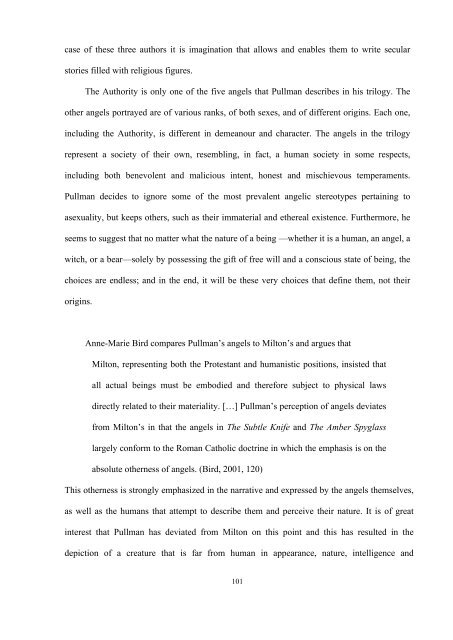The secular angel in contemporary children's literature: David ...
The secular angel in contemporary children's literature: David ...
The secular angel in contemporary children's literature: David ...
Create successful ePaper yourself
Turn your PDF publications into a flip-book with our unique Google optimized e-Paper software.
case of these three authors it is imag<strong>in</strong>ation that allows and enables them to write <strong>secular</strong><br />
stories filled with religious figures.<br />
<strong>The</strong> Authority is only one of the five <strong>angel</strong>s that Pullman describes <strong>in</strong> his trilogy. <strong>The</strong><br />
other <strong>angel</strong>s portrayed are of various ranks, of both sexes, and of different orig<strong>in</strong>s. Each one,<br />
<strong>in</strong>clud<strong>in</strong>g the Authority, is different <strong>in</strong> demeanour and character. <strong>The</strong> <strong>angel</strong>s <strong>in</strong> the trilogy<br />
represent a society of their own, resembl<strong>in</strong>g, <strong>in</strong> fact, a human society <strong>in</strong> some respects,<br />
<strong>in</strong>clud<strong>in</strong>g both benevolent and malicious <strong>in</strong>tent, honest and mischievous temperaments.<br />
Pullman decides to ignore some of the most prevalent <strong>angel</strong>ic stereotypes perta<strong>in</strong><strong>in</strong>g to<br />
asexuality, but keeps others, such as their immaterial and ethereal existence. Furthermore, he<br />
seems to suggest that no matter what the nature of a be<strong>in</strong>g —whether it is a human, an <strong>angel</strong>, a<br />
witch, or a bear—solely by possess<strong>in</strong>g the gift of free will and a conscious state of be<strong>in</strong>g, the<br />
choices are endless; and <strong>in</strong> the end, it will be these very choices that def<strong>in</strong>e them, not their<br />
orig<strong>in</strong>s.<br />
Anne-Marie Bird compares Pullman’s <strong>angel</strong>s to Milton’s and argues that<br />
Milton, represent<strong>in</strong>g both the Protestant and humanistic positions, <strong>in</strong>sisted that<br />
all actual be<strong>in</strong>gs must be embodied and therefore subject to physical laws<br />
directly related to their materiality. […] Pullman’s perception of <strong>angel</strong>s deviates<br />
from Milton’s <strong>in</strong> that the <strong>angel</strong>s <strong>in</strong> <strong>The</strong> Subtle Knife and <strong>The</strong> Amber Spyglass<br />
largely conform to the Roman Catholic doctr<strong>in</strong>e <strong>in</strong> which the emphasis is on the<br />
absolute otherness of <strong>angel</strong>s. (Bird, 2001, 120)<br />
This otherness is strongly emphasized <strong>in</strong> the narrative and expressed by the <strong>angel</strong>s themselves,<br />
as well as the humans that attempt to describe them and perceive their nature. It is of great<br />
<strong>in</strong>terest that Pullman has deviated from Milton on this po<strong>in</strong>t and this has resulted <strong>in</strong> the<br />
depiction of a creature that is far from human <strong>in</strong> appearance, nature, <strong>in</strong>telligence and<br />
101
















